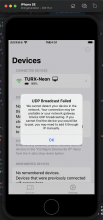(aka UDP broadcasting is disabled on the network):
The current Objective-C network backend already contains a check that lets the host device ignore its own ID packet when it is received (so it doesn't try to discover itself). However, on a network environment with UDP broadcasting disabled, the host's own ID packet will never be received by the host itself.
Perhaps this same check can be used to determine wether the host device is on a network environment with UDP broadcasting disabled, and then prompt the user to add devices directly by IP, since automatic discovery would be non-functional?
Perhaps the IP address of the host device can also be included in this prompt to save the user the trouble of going into settings can digging it out?
